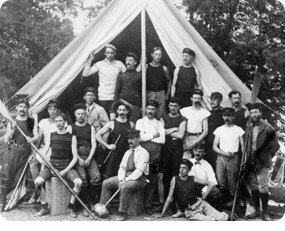
Camp leaders at the first YMCA camp
in the United States in 1887.
Local History
- In 1884 the YMCA was organized in Bristol, Tennessee, in a small frame building on Fourth Street with one table and seven benches.
- In 1888 the first permanent facility in Bristol, Tennessee, was erected on Fifth Street.
World History
- In 1872 the first Railroad YMCA was organized in Cleveland as a partnership between the YMCA and railroad companies to provide wholesome overnight lodging and meeting space for railroad workers.
- In San Francisco YMCAs serving Asians were established in 1875 to serve the large Chinese population there, and a Japanese YMCA was founded in 1917. U.S. Native Americans Ys started in 1879 with the founding of a YMCA by Thomas Wakeman, a Dakota Indian, in Flandreau, South Dakota.
- Camping became a cornerstone of YMCA programing in 1885 when the YMCA started Camp Dudley. America’s first known summer camp program was at Orange Lake, New York. The longest continually operating camp, its aim was to provide children with a positive developmental experience through making new friends, building confidence and growing in self-reliance.
- Designed to promote Christian character through fostering speech, sportsmanship and scholastic achievement, the Chapman, Kansas YMCA developed the Hi-Y club for high school boys in 1889. The service clubs ultimately became the “four fronts” program: Hi-Y, Jr. Hi-Y, Tri-HI, and Gra-Y and served youth of all ages.
- Founded in 1889 YMCA World Service raised awareness of and financial support for the powerful work of the global YMCA movement. Between 2000 and 2010 more than $10 million was raised to fund programs designed to empower youth and adults with the resources to create a better future for themselves and their families.
- In December, 1891, at the International YMCA Training School in Springfield, Massachusetts, the school’s director, Dr. Luther Gulick, gave physical education teacher James Naismith two weeks to come up with an indoor winter game to challenge a class of future Y directors. Naismith hung peach baskets to the bottom of a second level running track and taught the men this new game; basketball. Today basketball is second only to soccer as the most popular sport in the world.
- In the 1890s YMCA instructor William Morgan thought basketball was too strenuous for businessmen, so he blended elements of basketball, tennis and handball, and called his invention “mintonette”. In 1896 at the International YMCA Training School in Springfield, Massachusetts, the name “volley ball” was first used to describe the back-and-forth manner in which the ball flew over the net. Today more than 46 million Americans play volleyball.
- Early YMCAs created number of programs to make vocational and higher education available to more people, especially working class Americans. In 1893 large scale evening classes began at the Boston YMCA offering liberal arts and vocational courses. By 1950 YMCAs operated 20 colleges in cities across the country, and many of these YMCA-founded schools became freestanding institutions of higher learning.
Founding | 1800 – 1860s | 1870 – 1890s | 1900 – 1950s | 1960 – 1990s | 2000 – present

